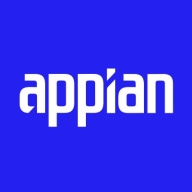

Appian and SnapLogic compete in the business process management and integration space. While SnapLogic excels in integration with robust data connectors and ETL capabilities, Appian stands out for its rapid app deployment and business process management features. Each has a competitive edge in their specific domains, with SnapLogic having the upper hand in flexibility and integration, and Appian in low-code app development.
Features: Appian's low-code development platform facilitates rapid application deployment, integration with various systems, and comprehensive process automation. It also offers robust data management and case management features. SnapLogic shines in large-scale data operations with its powerful ETL features and extensive data connectors, allowing seamless connection of different enterprise systems. Its low-code environment further enhances ease of integration across multiple platforms.
Room for Improvement: Appian faces challenges in flexibility within its user interface and complex model support, alongside limited DevOps integration. Its mobile and offline functionalities require refinement. SnapLogic can improve by enhancing API management and developing more out-of-the-box connectors for better integration. It should also focus on increasing support for transparency in data flows and improving ease of use.
Ease of Deployment and Customer Service: Appian offers flexible deployment options in public, hybrid, and on-premises environments, although its technical support often requires faster response times under rising demand pressures. SnapLogic provides hybrid and cloud deployment but needs to address challenges posed by enterprise-level complex processes. Enhancing support for complex integrations would benefit users seeking enterprise solutions.
Pricing and ROI: Appian's pricing may be a barrier for smaller businesses, yet many users report substantial ROI from accelerated deployment and improved operational efficiency. SnapLogic’s pricing model, based on connectors and data volume, often appears more affordable. It offers positive ROI when optimized for substantial complex integrations. Careful cost analysis is necessary to maximize ROI for both products, though SnapLogic is often favored for cost-effective integration solutions.
They see return on investment in terms of cost savings, time savings, more efficient processes, and more efficient employees.
Appian is very efficient, allowing us to build a lot of applications within a financial year, making it cost-effective.
SnapLogic is really helpful and processes in very little time, so it doesn't take much time compared to any legacy tool.
The technical support for Appian rates as 10 out of 10 because they have a great support team.
Their customer service is responsive, and the team is very prompt for support.
The technical support is generally good.
Some SMEs are allotted for the organization, so in case of any issue, we have their email IDs to contact them for support, including SMEs and community.
The technical support from SnapLogic is excellent, and I would give it a complete ten.
On a scale of one to 10, Appian rates as a nine for scalability.
Initially, without much coding, I can easily handle five thousand records.
Appian is scalable, but it depends on how you build your applications.
I rate the scalability of SnapLogic as eight out of ten.
It depends on how it has been designed and how it has been configured.
The stability of Appian would rate as nine, as it's a stable environment.
But recently, in a year, I haven't found many performance issues in SnapLogic.
I would rate the stability of SnapLogic as nearly ten out of ten.
It has room to improve for use cases where the users are public facing, where anonymous users could come to a site and run a business workflow or interact with some data.
I would like to see more enhancement in the user interface to allow more freedom in designing the sites and pages.
If there is a very complex process that includes a lot of data transitioning and memory-centric processes, it consumes a lot of memory.
If the AI capabilities and integrations were more intuitive and easy to learn for new users, it would be greatly beneficial.
They can improve more visuals, with graphical representations, such as how many things can be added, how many users can be added or dropped, and how the back-end nodes can be graphically shown in a better way.
I tend to frequently communicate with SnapLogic to ask for additional features, and they have been responsive.
On the pricier side, both Appian and Pega are enterprise-level solutions, placing them on the slightly higher side.
The pricing of Appian is based on the number of users and generally ranges from 70 to 100 USD per user per month.
The price of Appian, on a competitive landscape, is a little bit on the higher side for companies, rating maybe a 6.5.
There would be only one point of improvement if the price could be lower.
SnapLogic is positioned at around seven or eight out of ten in terms of pricing.
The zero-code integration feature is remarkable, allowing for ease of data transfer and workflow enhancement.
Appian also utilizes AI for business users, providing a feature called process each view, enabling business users to create their own dashboards, reports, and gain insights from their data and processes using artificial intelligence.
I can create tables, perform database-related activities, and create multiple tables.
I also like the whole child-parent pipeline feature; it allows me to break up a process into smaller pieces and then have one big pipeline that controls these smaller pipelines.
I find SnapLogic to be user-friendly, especially for beginners with limited experience in data engineering or ETL.
It's moving into AI, so we can create AI agents with LLM models. We can use most of the LLM such as Amazon Bedrock, OpenAI, Azure AI.
| Product | Market Share (%) |
|---|---|
| Appian | 5.8% |
| SnapLogic | 0.6% |
| Other | 93.6% |


| Company Size | Count |
|---|---|
| Small Business | 20 |
| Midsize Enterprise | 9 |
| Large Enterprise | 41 |
| Company Size | Count |
|---|---|
| Small Business | 11 |
| Midsize Enterprise | 5 |
| Large Enterprise | 10 |
Appian is a unified low-code platform and solution used by businesses to build enterprise applications and workflows. This product adapts to the needs of clients and the technologies they are already using to combine their data in a single workflow and maximize resources. The platform has four main components through which it transforms the work process for companies of various sizes. They are:
Appian is utilized across a diverse set of industries, including automotive and manufacturing, energy and utilities, education, financial services, telecom and media, transportation, retail, insurance, healthcare, and life sciences. The most frequent use cases of Appian are customer journey, governance, risk and compliance, operational efficiency, supply chain, distributed order management, and environmental, social, and governance (ESG) management.
Appian Features
Appian has various features that allow users to create solutions for their businesses. These features can be separated into a few groups according to function, including automation, low-code application development, and integrations and data. Some of the most frequently used features of Appian include:
Appian Benefits
The benefits of using Appian include:
Reviews from Real Users
A practice leader - digital process automation at a computer software company values Appian highly because the product is easy to develop, low-code, and has a good user interface.
Alan G., an advisory board member at Codecon VR, Appian offers a clear application life cycle, easy to learn documentation, and comes with a fundamentals course.
The SnapLogic Intelligent Integration Platform uses AI-powered workflows to automate all stages of IT integration projects – design, development, deployment, and maintenance – whether on-premises, in the cloud, or in hybrid environments. The platform’s easy-to-use, self-service interface enables both expert and citizen integrators to manage all application integration, data integration, API management, B2B integration, and data engineering projects on a single, scalable platform. With SnapLogic, organizations can connect all of their enterprise systems quickly and easily to automate business processes, accelerate analytics, and drive transformation.
We monitor all Process Automation reviews to prevent fraudulent reviews and keep review quality high. We do not post reviews by company employees or direct competitors. We validate each review for authenticity via cross-reference with LinkedIn, and personal follow-up with the reviewer when necessary.